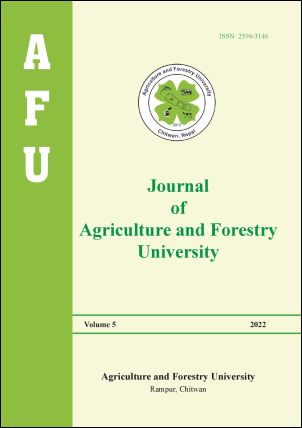Effectiveness of crop and livestock protection methods against wildlife damage: A case from Chitwan National Park, Nepal
DOI:
https://doi.org/10.3126/jafu.v5i1.48461Keywords:
Human-wildlife conflict, Wildlife damage management, Chitwan National ParkAbstract
Human-wildlife conflict is a major issue for policymakers and conservationists due to economic loss to the communities living in the close territory of the park, affecting their livelihoods and wellbeing. This study aims at identifying and quantifying wildlife-induced damages on crops and livestock and methods used by communities for crop and livestock protection. A total of 434 households living in the vicinity of the park from the ten forest user groups around the Chitwan national parks and buffer zone were randomly sampled and interviewed with the use of semi-structured questionnaires in the year 2021. Findings revealed a total of 87.86% of rice-growing households reported the damage of rice whereas 90.32% and 87.68% of households reported the damage to wheat and maize, respectively. The annual loss of 78 kg of rice per household (NRs. 1776 at prevailing market rates) was reported along with the loss of wheat (86 Kg-worth of NRs. 2,523) and maize (96 Kg-worth of NRs. 2,019) per household. About 59% of households had lost at least a livestock species and poultry in last year, and that varied well across the sectors. Twelve different methods and techniques were identified by communities that were used regularly to prevent crop damage and livestock loss with the majority of people using certain methods and techniques against crop damage and livestock loss. A total of 425 (97.93%) were reported that they used at least one method and technique to prevent crop damage and livestock loss. Among all these methods, crop guarding, shouting, use of natural fences, guarding by dogs, and throwing stones were the most effective and safest practices/techniques, but the use of a single means and approach was found ineffective. This suggests the need for developing site-specific management techniques to minimize crop damage and livestock loss in the National Park vicinity and adjoining protected areas. Apart from the different mitigating means, construction, and maintaining permanent fences on the border of the national parks, there should be the provision of conservation education to communities bordering protected areas to practice sustainable agriculture and income-generating programs that are conservation-friendly. that may include, for example, provision of conservation educations along with income-generating programs that are conservation-friendly.
Downloads
Downloads
Published
How to Cite
Issue
Section
License
Copyright (c) 2022 Agriculture and Forestry University (AFU), Rampur, Chitwan, Nepal

This work is licensed under a Creative Commons Attribution-NonCommercial 4.0 International License.
This license allows reusers to distribute, remix, adapt, and build upon the material in any medium or format for noncommercial purposes only, and only so long as attribution is given to the creator.




